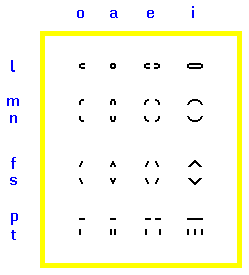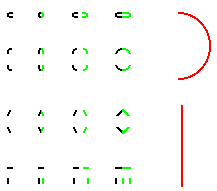
A syllable writing with 28 signs
This tiny syllable writing only wants to be an example, how such a
phonetic picture writing
may be designed and what problems occur.

We arranged the 28 signs in a table (7*4 matrix).
Example: The "horseshoe" on top left is spoken lo,
the ellipse on top right li, the triple vertical
line down right ti.
The syllable signs are designed systematically: The origin is
the vertical line down left (sign to).
If we turn it, we get a horizontal (po),
from left to right falling (so) or ascending
line (fo). If we curve the latter 2 signs,
we obtain the signs no and mo.
The sign lo we get by pressing down
the pair of signs nomo to the height of 1 sign.
The signs in the o-column are the left halves of the basic forms ellipse,
circle, rhomb and square, which one can recognize in the i-column.
All o-signs are in the left third of the space for a broad sign.
All other signs are developed from them systematically:
e: o-signed doubled by reflecting it to the right
(put a mirror on the right rim of the o-column !)
i: like e-sign, but closed in the middle
a: i-signed pressed together horizontally
By the left end of a syllable sign one can recognize the consonant.
(o-signs are consonant signs without any addition).
This makes clear the following picture, where we colored green
the rest of each sign:

It's easy to recognize the consonant, if you cover the right part
of a sign or a column of signs by a sheet of paper (try it now!).
Also the vowel of each syllable sign is easy to recognize:
o - single line at left rim, max. 1/3 broad,
any imagined horizontal line intersects the sign only 1 time
a - sign centered, narrow, small area
e - sign broad, gap in the middle
i - sign broad, no gap in the middle
That means, the lower a vowel sounds, the broader are all syllable signs
with this vowel, respectly the more to the right they extend:
from the left third in the sign field (o) to the middle third (a)
to the left and right third (e) to all 3 thirds (i).
Also the enclosed volume of the signs increases: o-signs contain
nor area (a horizontal section never cuts more than 1 line),
a-signs mostly a small area, e- and i-signs a big area.
Also the relation between consonant and syllable sign is systematic:
syllables with humming consonant (l,m,n) have
curved signs, syllables with not humming consonant "straight" signs
(composed out of 1 or more straight lines). From the latter ones, syllables with
hissing consonants (f,s) have slanting lines,
syllables with stopping (plosive) consonants have "rectangle"
lines (parallel to a coordinate axis). (The sound groups are explained in the
main article .)
Evaluation
Above syllable writing only wants to be a handy example for the
supposely best principle to construct a syllable writing:
Left end = consonant, prolongation to the right (breadth, position) = vowel.
Otherwise, the above syllable table is too small: Of course with 28
signs one can form better ideograms than with 16 or 20 letters of a
letter writing. But an ideogramm consisting of 5 letter signs is spoken
as 5 sounds (maybe + filling sounds), an ideogramm with 5 syllable signs
as 10 sounds - too many. Even though with 28 signs one can form not only
better, but often shorter ideograms (less signs), 28 syllable signs are too less.
A syllable writing to be used for phonetic picture writing should
have about as many spoken syllables as a letter writing, to avoid
monotonous speech and to make ideograms short. (The phonetic picture
writing with 16 letters has 72 syllables possible in ideograms,
that one with 20 letters 98.) Also 100 ore more syllables
are practicable, if the syllable signs are designed systematically.
The use of the mechanisms described here is free update: 13.12.05